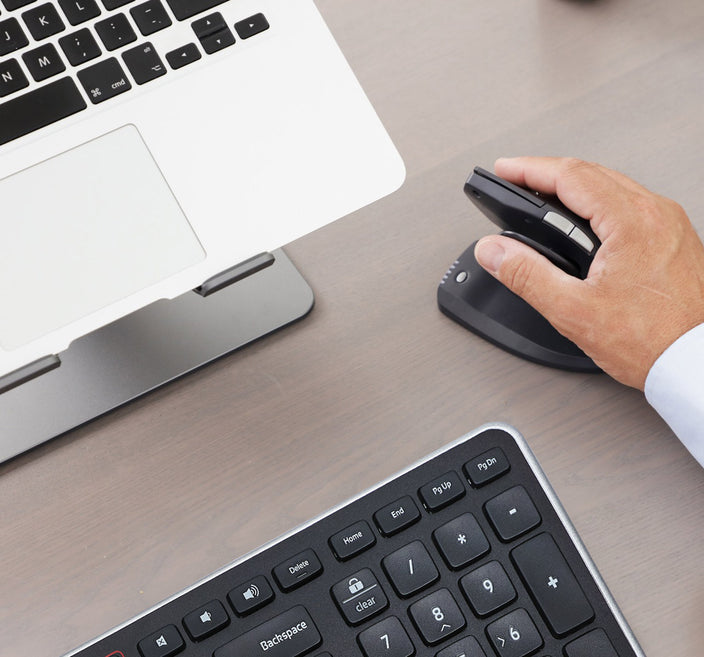54% of office workers, who use a computer mouse for an extended period daily, experience discomfort or pain. If you're suffering from a mouse arm, you are not alone. To avoid it, you need to make sure your working position is relaxed and varied throughout the day.
Countless people suffer from work-related conditions as a result of working with a traditional mouse. We have gathered four valuable tips for mouse arms that may help you reduce or eliminate the pain entirely.
1. Arrange your workstation so that it is beneficial for you
One of the first things you should do is make sure that your workstation provides a relaxed and varied working position, not the opposite.
"How do I do that?" you may ask.
A solid place to start is to consider the following:
- A height-adjustable desk that allows you to change your position throughout the day. It may be a good idea to start the day standing.
- An adjustable chair with a movable backrest and seat allows you to work in various working positions throughout the day and still receive optimal support.
- Good lighting, preferably a desk lamp, so you can move and adjust throughout the day.
- A height-adjustable monitor, which allows you to lift your eyes and reduce discomfort and tension.
- A compact keyboard encourages you to work within the ideal working zone in front of your body and reduces the strain on your arms and hands.
- A wrist rest gives you relief and a better pressure distribution between your hands and forearms.
- A centred computer mouse that forces you to work within the ideal working area in front of your body and ensures that you reduce the strain on your arms and hands.
Further reading: Reduce pain with an ergonomic mouse
2. Make sure that you spend most of your time working within the ideal working zone
At Contour, we use "the ideal working zone" to describe the area where you put the least strain on your body. Your hands should be by your elbows at waist height. From here, you should be able to reach the equipment you use most throughout the day. If you need to stretch for something, you will end up in the "outer working zone", which is not optimal for frequent use.
As long as you work within the ideal working zone, you will minimise the strain on your hands, arms, and shoulders. It will also allow your overstrained muscles and joints to recover.

Read about ergonomics in general here.
3. Exercise
Exercising the muscles in your upper body will help you deal with pain.
When seeing the word "Exercise", you probably think of the gym, which may be the solution for you. However, you can start with less. Do a few exercises every day at your workplace that only takes a few minutes. Which exercises you will benefit from the most depends on the pain you are struggling with.
Here are some exercises for wrists and arms that could be useful:
Exercise 1
This exercise works best when you are standing, but you can also do it seated.
- Intertwine your fingers and turn your palms facing down.
- Now stretch your palms forward before raising your arms over your head, fingers still intertwined.
Always remember to keep your shoulders down and away from your ears) - Do an extra stretch towards the ceiling.
Repeat this exercise several times a day.
This exercise stretches out your fingers, as well as the muscles in your forearms and chest.
Exercise 2
You can do this exercise while being seated.
- Stretch your arms out in front of your body.
- Bend one hand palm-side up and the other one palm-side down.
- Then turn your palms up and down alternately.
Repeat this exercise several times a day.
This exercise stretches out the muscles in your forearms.
Further reading: De Quervain's Tenosynovitis Exercises (source: Summit Medical Group)
4. Variation, Breaks, Movement
The last tip to keep your arms healthy is not sitting in the same working position all day.
It is not easy to remember, as we tend to be quite focused at work. As such, we are likely to ignore signals of fatigue or overstraining that our body shares with us. Breaks are essential – not just to enable you to stay concentrated on the task you are working on, but also to allow your body to change muscle groups and let the"office muscles" recover. Movement throughout the day facilitates the blood supply to your hands, arms and shoulders, making you more comfortable.
If you are suffering from a mouse arm, it is even more critical to change your working position throughout the day. Try to have a structured approach and plan that guarantees variation, breaks, and movement for the day. Some of the things that would be beneficial for you to try to incorporate into your day are:
- Switch between standing and sitting throughout the day if you have a height-adjustable desk. You can start the day standing up, and when you notice that you are beginning to lean on the desk, it is time to change your working position.
- You can lean back in your chair and put your feet on the desk when reading a long document or coming up with the next big thing. If you have access to a comfortable seating area, consider relocating there for a little while.
- What about doing your next casual meeting on a walk? Just put on your jacket and head outside. The fresh air will undoubtedly be beneficial for the meeting, and it will surely keep the agenda tight and to the point.
It will also allow getting a bit of daylight and fresh air, which is great for everyone in the dark winter months.
There are plenty of options. You need to get started.
Related read: Everything you need to know about your working environment.




